 Titelseite > Programmierung > Implementieren Sie schnell und einfach ein leistungsstarkes E-Commerce-System von Sponge+DTM
Titelseite > Programmierung > Implementieren Sie schnell und einfach ein leistungsstarkes E-Commerce-System von Sponge+DTM
Implementieren Sie schnell und einfach ein leistungsstarkes E-Commerce-System von Sponge+DTM
This article demonstrates how to use the Sponge framework to quickly build a simplified high-performance e-commerce system, implementing flash sale and order functionality, while ensuring data consistency through the Distributed Transaction Manager (DTM). The architecture of the e-commerce system is shown below:
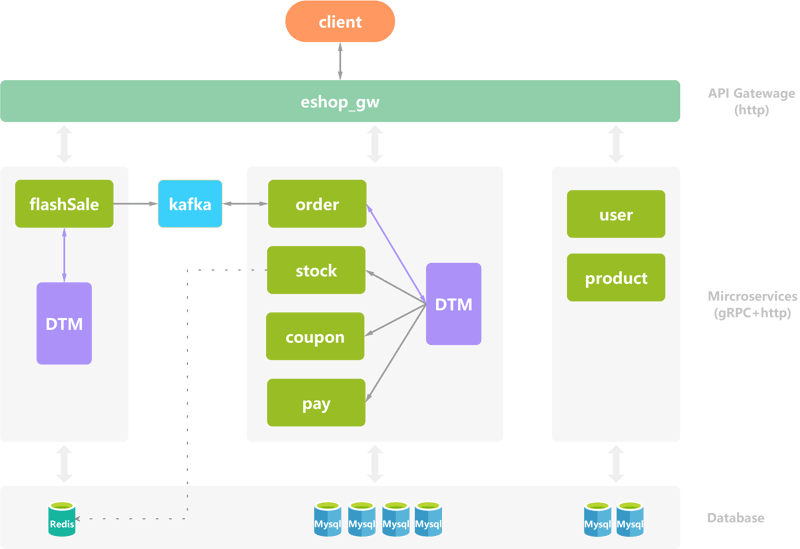
This is the source code example eshop, directory includes two identical code examples, but the code structure is slightly different, mainly to show that sponge supports the creation of microservices projects with different repository patterns, example-1-multi-repo is suitable for microservices multi-repo (multi-repo), example-2-mono-repo is suitable for microservices single repository (mono-repo).
Environment Setup
To build this e-commerce system, you need the following tools and dependencies:
- Sponge: A tool for rapidly generating service and module code for different systems. Follow the Sponge installation guide for more information.
Additionally, the following services are required:
- DTM: A distributed transaction manager for ensuring data consistency across multiple service calls.
- Redis: Used in conjunction with DTM to handle flash sale caching.
- Kafka: A message queue system for asynchronous order processing.
- MySQL: Database for storing service data.
All services will be running on a virtual machine with the IP address 192.168.3.37.
Launching DTM Services
DTM is a core component of this system, responsible for managing distributed transactions in the flash sale and order processes. Two DTM service instances are required—one for MySQL and one for Redis storage.
You can download DTM from the following link: https://github.com/dtm-labs/dtm/releases/tag/v1.18.0
| Service Name | Port Configuration |
|---|---|
| DTM-MySQL | HTTP: 36789, gRPC: 36790 |
| DTM-Redis | HTTP: 35789, gRPC: 35790 |
1. Launching DTM-MySQL Service
-
Import the required table structure into MySQL:
- dtmcli.barrier.mysql.sql
- dtmsvr.storage.mysql.sql
Modify the DTM configuration file (Sample Configuration):
Store: # specify which engine to store trans status
Driver: 'mysql'
Host: '192.168.3.37'
User: 'root'
Password: '123456'
Port: 3306
Db: 'dtm'
- Start the DTM service:
./dtm -c conf.yml
2. Launching DTM-Redis Service
- Modify the DTM configuration file (Sample Configuration):
Store: # specify which engine to store trans status
Driver: 'redis'
Host: '192.168.3.37'
User: 'default'
Password: '123456'
Port: 6379
- Start the DTM service:
./dtm -c conf.yml
Rapid Development of an E-Commerce System Using Sponge
The simplified e-commerce system consists of the following eight microservices:
- eshop_gw: API gateway service
- user: User service
- product: Product service
- order: Order service
- stock: Stock service
- coupon: Coupon service
- pay: Payment service
- flashSale: Flash sale service
1. Prepare MySQL Databases and Tables for Each Service
Import the corresponding database tables for each service into MySQL:
- User service schema
- Product service schema
- Order service schema
- Stock service schema
- Coupon service schema
- Payment service schema
2. Prepare Protobuf Files for Each Service
These protobuf files allow Sponge to quickly create services:
- User service protobuf
- Product service protobuf
- Order service protobuf
- Stock service protobuf
- Coupon service protobuf
- Payment service protobuf
- Flash sale service protobuf
- API Gateway protobuf
3. Generate gRPC HTTP Hybrid Service Code Based on Protobuf
Open the sponge UI page, switch to the menu Protobuf --> Create grpc http service, fill in the parameters, and generate 7 hybrid service codes that support both grpc and http: user, product, order, stock, coupon, pay, flashSale, as shown below:
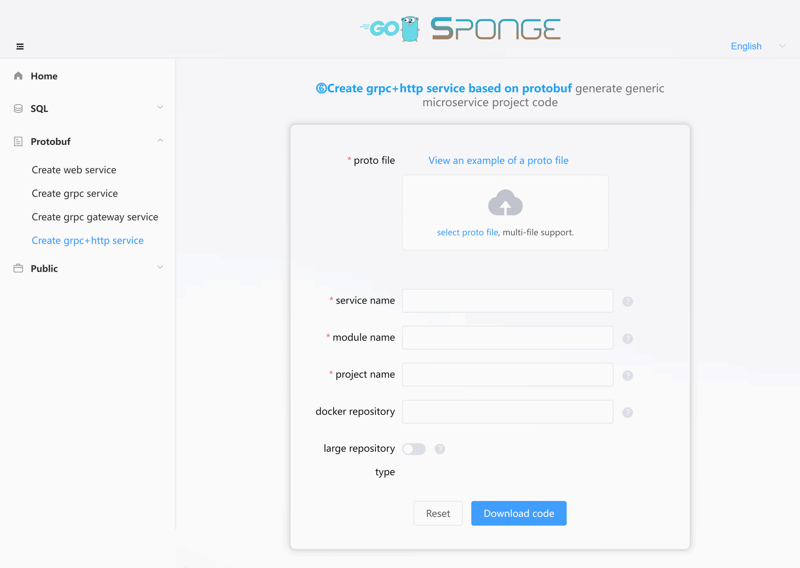
After downloading the code, unzip each service code into the eshop directory.
Note: If the large repository option is enabled on the code generation page, it means that the created service is suitable for a microservice mono-repo mode.
4. Generate CRUD Code Based on MySQL Tables
Open the sponge UI page, switch to the menu Public --> Generate service handler CRUD code, fill in the parameters, and generate CRUD codes for the user, product, order, stock, coupon, and pay services, as shown below:
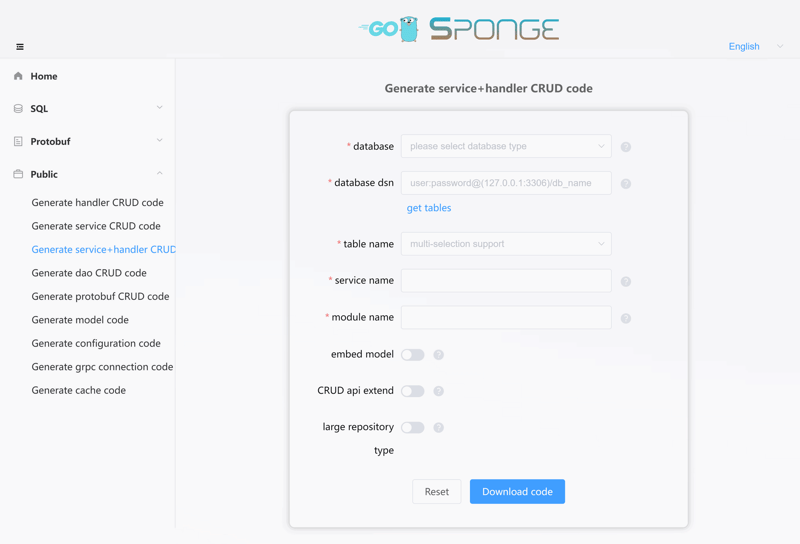
After downloading the code, unzip the CRUD code and move the CRUD code (the api and internal directories) into the corresponding service code (if prompted with duplicate proto files, just ignore it).
Note: If the large repository option is enabled on the code generation page, it means that the created service is suitable for a microservice mono-repo mode.
5. Generate API Gateway Service Code Based on Protobuf
Open the sponge UI page, switch to the menu Protobuf --> Create grpc gateway service, fill in the parameters, and generate the API gateway service code for eshop_gw, as shown below:
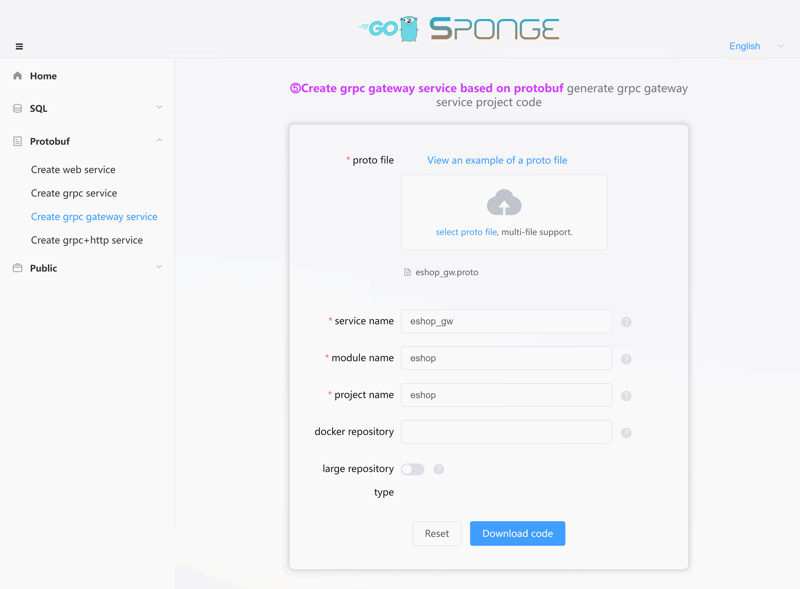
After downloading the code, unzip the service code into the eshop directory.
To allow the eshop_gw service to connect to the various services, you need to generate the connection code. Open the sponge UI page, switch to the menu Public --> Generate grpc connection code, fill in the parameters, and generate the connection code for eshop_gw to connect to various grpc services, as shown below:
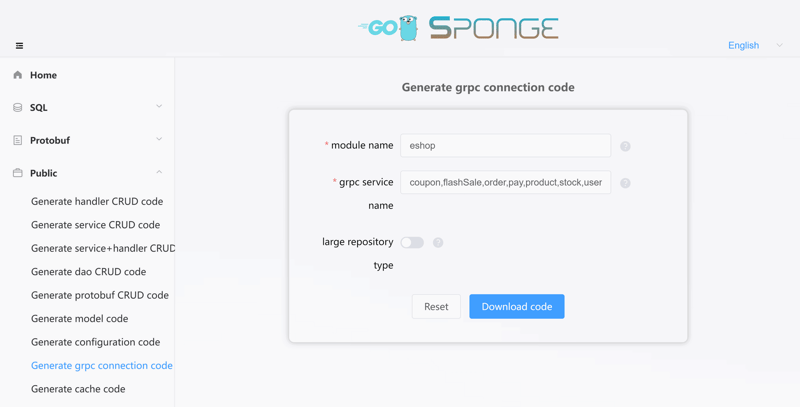
After downloading the code, unzip it, and move the connection code (the internal directory) into the eshop_gw service code.
Note: If the large repository option is enabled on the code generation page, it means that the created service is suitable for a microservice mono-repo mode.
6. Write Business Logic Code
At this point, the service framework is basically set up. Next, write the actual business logic code in the internal/service directory of each service.
7. Start the Services
Before starting the services, modify the configuration files of each service, including the port numbers, database connections, etc. The default HTTP port for each service is 8080, and the grpc port is 8282. Since they are running locally on the same machine (local test IP is 192.168.3.90), to avoid port conflicts, the ports of each service have been modified (ports can be found and modified in the configs/xxx.yml directory and api/xxx/v1/xxx.proto). Below are the modified ports:
| Service | Protocol | HTTP Port | gRPC Port |
|---|---|---|---|
| eshop_gw | HTTP | 8080 | - |
| user | HTTP, gRPC | 30080 | 30082 |
| product | HTTP, gRPC | 30180 | 30182 |
| order | HTTP, gRPC | 30280 | 30282 |
| stock | HTTP, gRPC | 30380 | 30382 |
| coupon | HTTP, gRPC | 30480 | 30482 |
| pay | HTTP, gRPC | 30580 | 30582 |
| flashSale | HTTP, gRPC | 30680 | 30682 |
Note: If running in containers or on different machines, you don’t need to modify the default ports, just change the mapped ports.
Testing and Verification
Single Service Testing
After all services have successfully started, verify that each service is functioning properly by testing the APIs of the following 7 services: user, product, order, stock, coupon, pay, and flashSale.
Open your browser and navigate to http://localhost:
Integration Testing
Once individual services pass the tests, use the API gateway service of eshop_gw to test the entire system. In your browser, visit the Swagger page of the API gateway service at http://localhost:8080/apis/swagger/index.html, as shown in the figure below:
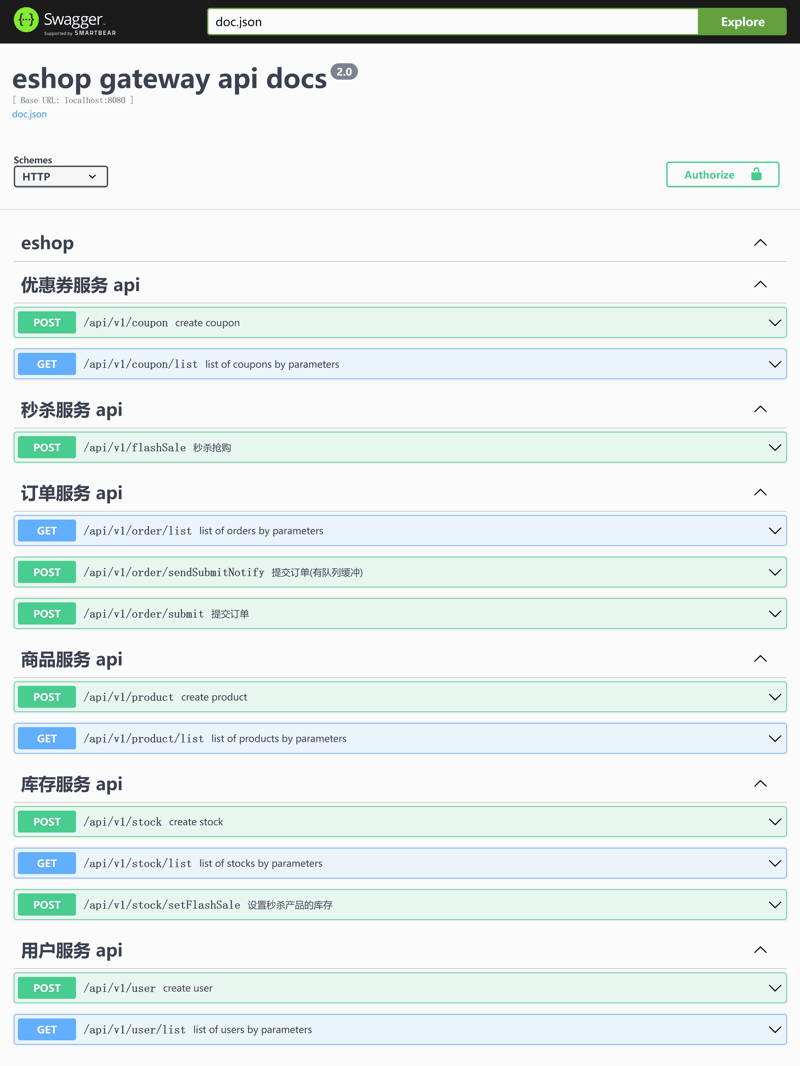
Testing the Submit Order API
The submit order process uses DTM's distributed transaction model saga, mainly to verify the consistency of creating orders, deducting stock, creating payment orders, and coupon data.
To avoid order failure due to insufficient stock, set the stock before testing. In the Swagger page, find the API for setting product stock, and fill in the parameters. For example, set product ID to 1 and stock to 10:
{
"productID": 1,
"stock": 10
}
- Test the submit order API by requesting both the non-buffered queue and buffered queue APIs. In the Swagger page, find the respective API and fill in the parameters, such as user ID = 1, product ID = 1, product quantity = 1, and order amount = 100:
{
"userID": 1,
"productID": 1,
"productCount": 1,
"amount": 100,
"couponID": 0
}
Note: If couponID is not set to 0, it means a coupon will be used. If the coupon is invalid or expired, the order will fail. To ensure the order succeeds, find the API for creating a new coupon on the Swagger page, create a new coupon, get the coupon ID, and fill it into the couponID field of the submit order API.
Testing the Flash Sale API
The flash sale process uses Kafka's message queue, DTM Redis's two-phase message, and DTM MySQL's saga distributed transaction models to verify consistency in flash sales, stock deduction, order creation, and payment order creation.
To avoid order failure due to insufficient stock, set the stock before testing. In the Swagger page, find the API for setting product stock and fill in the parameters. For example, set product ID to 1 and stock to 10:
{
"productID": 1,
"stock": 10
}
- Test the flash sale API to verify data consistency. In the Swagger page, find the flash sale API and fill in the parameters, such as user ID = 1 and product ID = 1:
{
"userID": 1,
"productID": 1,
"amount": 100
}
Stress Testing
To perform stress testing on the eshop_gw API gateway service and verify the system's performance under high concurrency, use the stress testing tool k6. Before conducting the stress test, ensure that enough stock is set to avoid order failure.
-
For stress testing the Submit Order API scenario, use the k6 script submitOrder.js and run the following command:
# 1000 virtual users, running for 10 seconds k6 run --vus 1000 --duration 10s test/k6/submitOrder.js # Alternatively, specify the number of virtual users and the number of request iterations, for example, 1000 virtual users performing 100,000 request iterations k6 run -u 1000 -i 100000 submit_order.js
For stress testing the Flash Sale API scenario, use the k6 script flashSale.js and run the following command:
# 10,000 virtual users, running for 1 second k6 run --vus 10000 --duration 1s test/k6/flashSale.js
Note: The results of stress testing depend on factors such as machine configuration, network environment, and database setup. Adjust accordingly based on actual conditions.
Summary
This example shows how to quickly build a high-performance e-commerce system. The system architecture is divided into user, product, order, inventory, payment, flash sale and other services, each service code (excluding business logic code) can be generated by Sponge, using DTM to ensure data consistency under high concurrency flash sale, order scenarios. By integrating Redis and Kafka, the system also has efficient caching and message queuing support, improving overall performance and scalability.
-
 Bootstrap-DienstprogrammeBootstrap-Dienstprogramme sind leistungsstarke Klassen, die die Gestaltung Ihrer Website einfacher und schneller machen, ohne dass Sie benutzerdefinie...Programmierung Veröffentlicht am 07.11.2024
Bootstrap-DienstprogrammeBootstrap-Dienstprogramme sind leistungsstarke Klassen, die die Gestaltung Ihrer Website einfacher und schneller machen, ohne dass Sie benutzerdefinie...Programmierung Veröffentlicht am 07.11.2024 -
 Behebung des versteckten Überlaufs für Dropdowns/Tooltips uswHaben Sie schon einmal versucht, ein Dropdown-Menü für Ihre Schaltfläche zu erstellen, diese auszuwählen, aber dann durch den ausgeblendeten Überlauf ...Programmierung Veröffentlicht am 07.11.2024
Behebung des versteckten Überlaufs für Dropdowns/Tooltips uswHaben Sie schon einmal versucht, ein Dropdown-Menü für Ihre Schaltfläche zu erstellen, diese auszuwählen, aber dann durch den ausgeblendeten Überlauf ...Programmierung Veröffentlicht am 07.11.2024 -
 Wie kann ich Fehler in meiner Gin-Webanwendung mithilfe eines Middleware-Ansatzes effektiv behandeln?Verbesserung der Fehlerbehandlung in GinDie benutzerdefinierte Fehlerbehandlung mit Gin umfasst die Verwendung einer Middleware zur Verarbeitung von F...Programmierung Veröffentlicht am 07.11.2024
Wie kann ich Fehler in meiner Gin-Webanwendung mithilfe eines Middleware-Ansatzes effektiv behandeln?Verbesserung der Fehlerbehandlung in GinDie benutzerdefinierte Fehlerbehandlung mit Gin umfasst die Verwendung einer Middleware zur Verarbeitung von F...Programmierung Veröffentlicht am 07.11.2024 -
 So veröffentlichen Sie einen Artikel auf Medium mit Python und der Medium-APIEinführung Als jemand, der Obsidian zum Schreiben von Artikeln verwendet, muss ich meine Inhalte beim Veröffentlichen auf Medium oft manuell ...Programmierung Veröffentlicht am 07.11.2024
So veröffentlichen Sie einen Artikel auf Medium mit Python und der Medium-APIEinführung Als jemand, der Obsidian zum Schreiben von Artikeln verwendet, muss ich meine Inhalte beim Veröffentlichen auf Medium oft manuell ...Programmierung Veröffentlicht am 07.11.2024 -
 Wie werden Unicode-Zeichenreferenzen verwendet, um Prozentsätze in CSS-Klassennamen darzustellen?Was bedeutet .container.\31 25\25 in CSS?In CSS können Bezeichner Sonderzeichen enthalten, z der Backslash (). Das Backslash-Zeichen dient in CSS je n...Programmierung Veröffentlicht am 07.11.2024
Wie werden Unicode-Zeichenreferenzen verwendet, um Prozentsätze in CSS-Klassennamen darzustellen?Was bedeutet .container.\31 25\25 in CSS?In CSS können Bezeichner Sonderzeichen enthalten, z der Backslash (). Das Backslash-Zeichen dient in CSS je n...Programmierung Veröffentlicht am 07.11.2024 -
 Job-Tracking-AnwendungErstellen einer Job-Tracking-Anwendung mit dem MERN-Stack Auf dem heutigen wettbewerbsintensiven Arbeitsmarkt kann es eine Herausforderung se...Programmierung Veröffentlicht am 07.11.2024
Job-Tracking-AnwendungErstellen einer Job-Tracking-Anwendung mit dem MERN-Stack Auf dem heutigen wettbewerbsintensiven Arbeitsmarkt kann es eine Herausforderung se...Programmierung Veröffentlicht am 07.11.2024 -
 Hat „long“ in C++ garantiert mindestens 32 Bits?Hat Long garantiert 32 Bits?Trotz allgemeiner Annahmen basierend auf dem C-Standard stellt sich die Frage, ob Long garantiert 32 Bits hat mindestens 3...Programmierung Veröffentlicht am 07.11.2024
Hat „long“ in C++ garantiert mindestens 32 Bits?Hat Long garantiert 32 Bits?Trotz allgemeiner Annahmen basierend auf dem C-Standard stellt sich die Frage, ob Long garantiert 32 Bits hat mindestens 3...Programmierung Veröffentlicht am 07.11.2024 -
 Die WeightedGraph-KlasseThe WeightedGraph class extends AbstractGraph. The preceding chapter designed the Graph interface, the AbstractGraph class, and the UnweightedGraph cl...Programmierung Veröffentlicht am 07.11.2024
Die WeightedGraph-KlasseThe WeightedGraph class extends AbstractGraph. The preceding chapter designed the Graph interface, the AbstractGraph class, and the UnweightedGraph cl...Programmierung Veröffentlicht am 07.11.2024 -
 Vom Anfänger zum Ninja: Die Macht von Git für Entwickler freischaltenGit ist ein unverzichtbares Werkzeug im Toolkit jedes Entwicklers. Es hilft Ihnen nicht nur, Ihre Codebasis effizient zu verwalten, sondern ermöglicht...Programmierung Veröffentlicht am 07.11.2024
Vom Anfänger zum Ninja: Die Macht von Git für Entwickler freischaltenGit ist ein unverzichtbares Werkzeug im Toolkit jedes Entwicklers. Es hilft Ihnen nicht nur, Ihre Codebasis effizient zu verwalten, sondern ermöglicht...Programmierung Veröffentlicht am 07.11.2024 -
 Ist der Universal Selector in modernen Browsern immer noch ein Leistungskiller?Auswirkungen des Universal Selectors auf die LeistungDer Universal Selector (*) wendet CSS-Stile auf alle Elemente in einem Dokument an. Während es ei...Programmierung Veröffentlicht am 07.11.2024
Ist der Universal Selector in modernen Browsern immer noch ein Leistungskiller?Auswirkungen des Universal Selectors auf die LeistungDer Universal Selector (*) wendet CSS-Stile auf alle Elemente in einem Dokument an. Während es ei...Programmierung Veröffentlicht am 07.11.2024 -
 Ist „string::c_str()“ von C++11 immer noch nullterminiert?Entfernt string::c_str() von C 11 die Nullterminierung?In C 11 ist string::c_str nicht mehr garantiert Erzeugt eine nullterminierte Zeichenfolge.Grund...Programmierung Veröffentlicht am 07.11.2024
Ist „string::c_str()“ von C++11 immer noch nullterminiert?Entfernt string::c_str() von C 11 die Nullterminierung?In C 11 ist string::c_str nicht mehr garantiert Erzeugt eine nullterminierte Zeichenfolge.Grund...Programmierung Veröffentlicht am 07.11.2024 -
 Zip-Optionen in Effect-TS: Ein praktischer LeitfadenZip-Optionen in Effect-TS: Ein praktischer Leitfaden In der funktionalen Programmierung ist die sichere und vorhersehbare Kombination mehrere...Programmierung Veröffentlicht am 07.11.2024
Zip-Optionen in Effect-TS: Ein praktischer LeitfadenZip-Optionen in Effect-TS: Ein praktischer Leitfaden In der funktionalen Programmierung ist die sichere und vorhersehbare Kombination mehrere...Programmierung Veröffentlicht am 07.11.2024 -
 Erweitern Sie Ihr JavaScript: Ein tiefer Einblick in die objektorientierte Programmierung✨Objektorientierte Programmierung (OOP) ist ein leistungsstarkes Paradigma, das die Art und Weise, wie wir Code strukturieren und organisieren, revolut...Programmierung Veröffentlicht am 07.11.2024
Erweitern Sie Ihr JavaScript: Ein tiefer Einblick in die objektorientierte Programmierung✨Objektorientierte Programmierung (OOP) ist ein leistungsstarkes Paradigma, das die Art und Weise, wie wir Code strukturieren und organisieren, revolut...Programmierung Veröffentlicht am 07.11.2024 -
 So erfassen Sie mehrere Gruppen in Anführungszeichen in Go: Eine Regex-LösungErfassen mehrerer Gruppen in Anführungszeichen in GoDieser Artikel befasst sich mit der Herausforderung beim Parsen von Zeichenfolgen, die einem besti...Programmierung Veröffentlicht am 07.11.2024
So erfassen Sie mehrere Gruppen in Anführungszeichen in Go: Eine Regex-LösungErfassen mehrerer Gruppen in Anführungszeichen in GoDieser Artikel befasst sich mit der Herausforderung beim Parsen von Zeichenfolgen, die einem besti...Programmierung Veröffentlicht am 07.11.2024 -
 Vom Anfänger zum Baumeister: Die Kunst der PHP-Programmierung beherrschenMöchten Sie PHP-Programmierung lernen? Schritt-für-Schritt-Anleitung, die Ihnen den Einstieg erleichtert! Installieren Sie zunächst PHP ([Offizielle W...Programmierung Veröffentlicht am 07.11.2024
Vom Anfänger zum Baumeister: Die Kunst der PHP-Programmierung beherrschenMöchten Sie PHP-Programmierung lernen? Schritt-für-Schritt-Anleitung, die Ihnen den Einstieg erleichtert! Installieren Sie zunächst PHP ([Offizielle W...Programmierung Veröffentlicht am 07.11.2024
Chinesisch lernen
- 1 Wie sagt man „gehen“ auf Chinesisch? 走路 Chinesische Aussprache, 走路 Chinesisch lernen
- 2 Wie sagt man auf Chinesisch „Flugzeug nehmen“? 坐飞机 Chinesische Aussprache, 坐飞机 Chinesisch lernen
- 3 Wie sagt man auf Chinesisch „einen Zug nehmen“? 坐火车 Chinesische Aussprache, 坐火车 Chinesisch lernen
- 4 Wie sagt man auf Chinesisch „Bus nehmen“? 坐车 Chinesische Aussprache, 坐车 Chinesisch lernen
- 5 Wie sagt man „Fahren“ auf Chinesisch? 开车 Chinesische Aussprache, 开车 Chinesisch lernen
- 6 Wie sagt man Schwimmen auf Chinesisch? 游泳 Chinesische Aussprache, 游泳 Chinesisch lernen
- 7 Wie sagt man auf Chinesisch „Fahrrad fahren“? 骑自行车 Chinesische Aussprache, 骑自行车 Chinesisch lernen
- 8 Wie sagt man auf Chinesisch Hallo? 你好Chinesische Aussprache, 你好Chinesisch lernen
- 9 Wie sagt man „Danke“ auf Chinesisch? 谢谢Chinesische Aussprache, 谢谢Chinesisch lernen
- 10 How to say goodbye in Chinese? 再见Chinese pronunciation, 再见Chinese learning
























